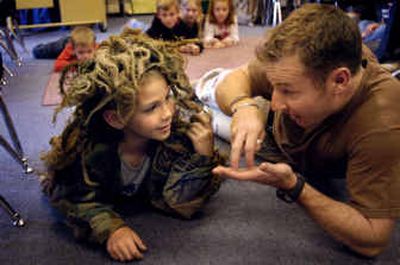Guardsmen treated as heroes in visit to elementary school

More than a dozen soldiers from the Army National Guard’s 81st Brigade got a hero’s welcome Friday at Greenacres Elementary School.
Students, several of whom have fathers serving in the brigade, sent care packages and letters to the soldiers while they were in Iraq. The soldiers, of the 1st Battalion, 161st Infantry, came back a month ago, and the school had an assembly to officially welcome them home.
Platoon leader Staff Sgt. Robert Cayce thanked the children for their support.
“We went and did our job,” he said. “We’re just happy to be home.”
Almost all the soldiers at the school were from Cayce’s 21-man platoon. They spent a year at Forward Operating Base Highlander, later renamed Prosperity, in Baghdad. To illustrate what they wore while out on patrol, Cayce had a student don a bullet-proof vest, pack and Kevlar helmet.
After the assembly, the soldiers scattered to classrooms to answer questions. One that came up a lot was about the food the soldiers ate. None seemed to be fans of MREs (Meals Ready to Eat) or the food that was served after a kitchen was set up.
“We ate chicken almost every night,” said Capt. Matthew Shea.
“And it was Army chicken, which is not good chicken,” said Sgt. John Fisher.
Sgt. Mathew Mikolas told students that soldiers sometimes got so dehydrated they needed intravenous fluids.
“It gets so hot, I can’t even describe how hot,” he said. “Within five or 10 minutes it feels like you just got out of the shower you’re so wet. You’re sweating faster than you can drink.”
Fisher told students there was always gunfire in the distance. Most of the time, the men didn’t know whether they were the ones being shot at.
“Every once in a while one will whiz by your head,” he said.
The soldiers also brought a camouflage-painted Humvee for the kids to examine and sit in. Some students tested the horn to make sure it worked. It did.
His soldiers were grateful to get the students’ packages, said Cayce, and not just because the treats were a welcome addition to military food.
“It’s just the connection to home,” he said.
Hand-drawn pictures included in the packages often ended up hanging on the walls. Some soldiers kept up an ongoing correspondence with students.
“It was a really important thing to us,” Cayce said.